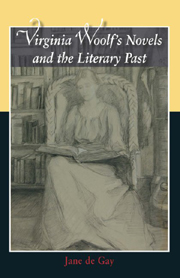Book contents
- Frontmatter
- Contents
- Acknowledgements
- Abbreviations
- Introduction
- 1 From Woman Reader to Woman Writer: The Voyage Out
- 2 Tradition and Exploration in Night and Day
- 3 Literature and Survival: Jacob's Room and Mrs Dalloway
- 4 To the Lighthouse and the Ghost of Leslie Stephen
- 5 Rewriting Literary History in Orlando
- 6 ‘Lives Together’: Literary and Spiritual Autobiographies in The Waves
- 7 Bringing the Literary Past to Life in Between the Acts
- Conclusion
- Select Bibliography
- Index
Conclusion
Published online by Cambridge University Press: 12 September 2012
- Frontmatter
- Contents
- Acknowledgements
- Abbreviations
- Introduction
- 1 From Woman Reader to Woman Writer: The Voyage Out
- 2 Tradition and Exploration in Night and Day
- 3 Literature and Survival: Jacob's Room and Mrs Dalloway
- 4 To the Lighthouse and the Ghost of Leslie Stephen
- 5 Rewriting Literary History in Orlando
- 6 ‘Lives Together’: Literary and Spiritual Autobiographies in The Waves
- 7 Bringing the Literary Past to Life in Between the Acts
- Conclusion
- Select Bibliography
- Index
Summary
We can now see that Woolf's novels were informed deeply by her sometimes vexed, sometimes positive conversations with past writers. As the analyses of her creative processes in the preceding chapters reveal, her reading and writing practices were closely interfused: quite simply, she needed to read in order to write, and almost invariably she preferred to read past writers. Sometimes she needed to read for intellectual stimulation: it is significant that she began to draft The Voyage Out after six years of intensive reading, but even in the 1930s, reading poetry helped release her from creative deadlock whilst formulating The Waves. Woolf also used past writings to help her make sense of the world and its problems – not least war and patriarchy – and as a consequence these works informed the thematic content of her novels.
Reading earlier literature also helped Woolf explore her own preoccupations and sensibilities, such as when she read Sterne in 1926 while considering the future of the novel in general and of her own writing in particular, or when she saw in Coleridge's agonies her own sense of being overwhelmed by experience. These empathetic readings in turn helped her articulate traumatic experiences of her own, such as when she used the classical image of birds singing in Greek in describing her breakdown of 1904, or when she drew on Romantic models to help develop her ‘moments of being’. Reading was so central to Woolf's understanding of the world that re-reading texts also became a form of self-discovery, a revisiting of self and past. This is most evident in The Waves, where in an intense reflexive exploration of her own process, she revisited works which had inspired her: for example, while writing the second typescript she re-read and quoted from Dante who had stimulated her earliest sketches for the novel.
- Type
- Chapter
- Information
- Virginia Woolf's Novels and the Literary Past , pp. 212 - 215Publisher: Edinburgh University PressPrint publication year: 2006

